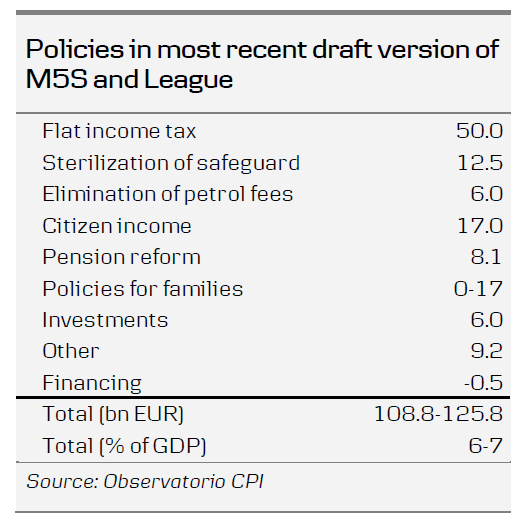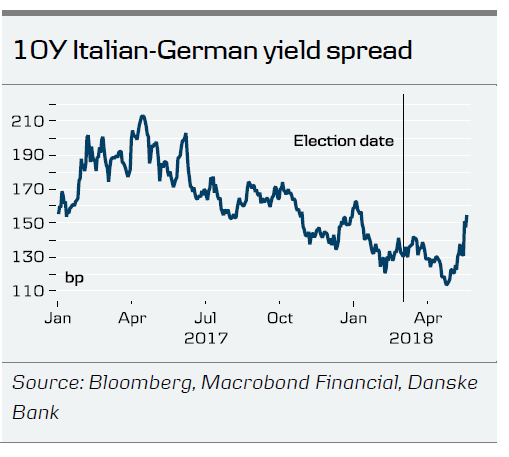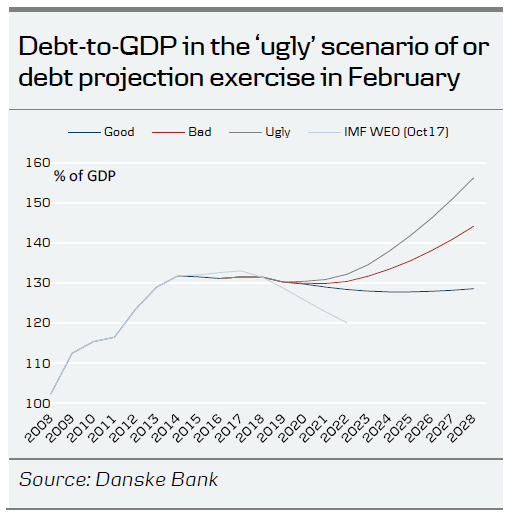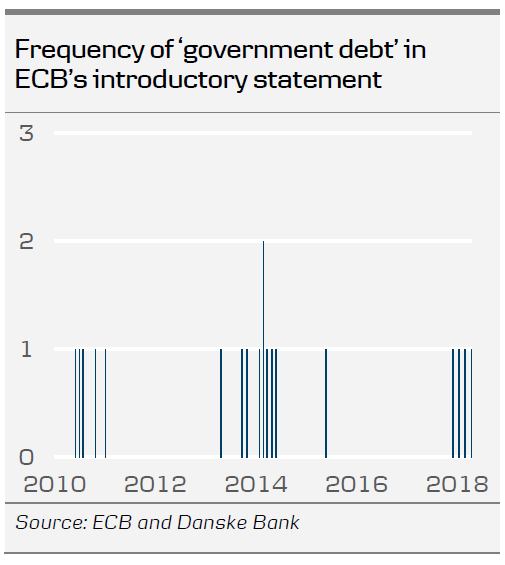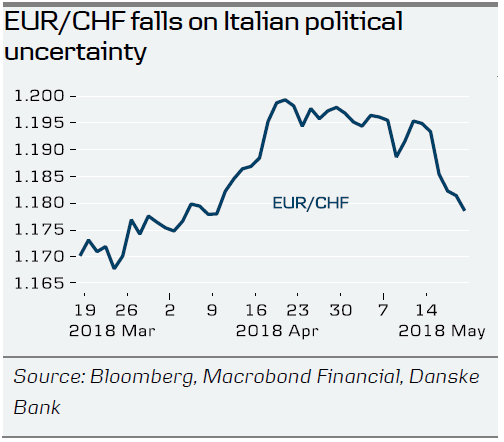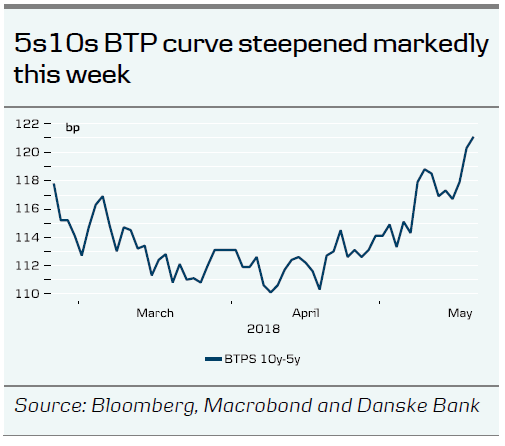This week, Italian election headlines have been dominating financial markets, as there seems to have been a breakthrough in the formation of a new government. Benchmark yield spreads vis-à-vis Germany are now at higher levels than prior to the election. In the context of the famous spaghetti western movie, ‘The good, the bad, the ugly’, we may be moving towards an ugly scenario for both Italy and Europe (which we laid out in our Election Monitor – The good, the bad and the ugly scenarios for Italy, 25 February). The coalition’s draft proposal is in clear breach of EU rules, in our view; hence, we expect a sharp reaction from Brussels. Consequently, heightened uncertainty should be expected in the near future, until a more fiscally modest policy programme is presented from the Italian side.
The draft agreement
A draft agreement leaked on Sunday entailed some very unrealistic initiatives, such as debt forgiveness by the ECB of EUR250bn, the ECB’s PSPP holdings not counting in the Maastricht debt-to-GDP ratio as well as a euro opt-out mechanism spooked fears in markets. In addition, a flat tax (entailing a sizeable income tax cut) and rollback of pension reforms was received with the same scepticism by markets.
While the M5S/League coalition pushed back, pointing to this leaked agreement being an old version, the initiatives still took their toll on markets and indicated the kind of government proposals that may come. Early in the week, the prime positive note from the headlines was that the coalition indicated that it would only propose a budget that would be realistic for Brussels to accept.
Nevertheless, the most recent draft from Thursday, still including fiscal easing measures, indicated an order of expansion of around EUR109-126bn, according to Italian Observatoria CPI (see table to the right). The most expensive measure is the introduction of a flat tax estimated at EUR50bn, followed by citizenship income. What is striking with this proposal is that financing only accounts for EUR0.5bn. All in all, this proposal would equate to an expansion of fiscal expenditures by 6-7% of GDP, which on ‘back of the envelope’ calculations could increase Italian fiscal deficit to 5-6% of GDP (adjusting for fiscal multiplier), and would clearly breach the EU’s excessive deficit procedure rules.
Furthermore, the idea of excluding the ECB-held part of Italian sovereign debt from the Maastricht Treaty debt definition would not fly with the Eurostat and EU commission either. More concerning is that some of the proposed initiatives (such as citizenship income) even reinforce the structural problems that the economy is facing.
Looking ahead, as long as the president views a potential government formation with proposals that are not seen as unconstitutional, the negotiations could drag on. Nevertheless, Monday next week is claimed by the coalition to be the focal date when a prime minister candidate will be announced. Regarding the unconstitutional proposals, the current very unbalanced (expenditure financing) proposal could be seen as unconstitutional. In addition, the coalition’s intentions to establish a government body that operated to settle disputes within the coalition could also be viewed as unconstitutional.
Only in the case of the president not seeing progress can he either propose a technocratled government or call for new elections.
View from Brussels: the ancient Roman debt tragedy unfolding
While the proposals and the government formation are in clear breach of the excessive deficit procedure rules and therefore not welcomed by Brussels, the market pressure observed over the past few days will probably suit Brussels well, hoping that the market will make the new government think twice. For now, until a concrete official government programme is available, however, we expect Brussels to stay silent.
Furthermore, even in a marked sell-off, we would have to observe dramatically higher rates in order for the ECB to step in at this stage. In return for any support from the ECB’s side, there would have to be a more credible policy programme in place, possibly agreed between Italy and the ESM. The last time the ECB was seriously concerned about market pressure was in 2012, when Mario Draghi uttered the famous three words ‘whatever it takes’. At that stage, 10Y BTP yields were touching 6.5%. However, the Monti government was also undertaking fiscal austerity and structural reforms in striking contrast with the new Italian government’s policy intentions.
That said, since December 2017, the ECB has voiced concerns about government debt levels and made reference to this subject in its introductory statement in March 2018. The subject is now firmly back in the introductory statement after being absent for almost three years as references to ‘governing debt’ were very frequent in 2014 (the ECB took note of positive developments in 2015). Prior to the Italian elections, we outlined the debt dynamics in different coalition agreements. In the piece, which is the ‘ugly’ scenario, we took into account the proposals at that time and that debt/GDP levels could rise to 156% in 2028.
On a final note, we emphasise that there is no longer a euro exit plan in the draft proposal, which would be viewed positively by Brussels. However, according to EU, it should never have been discussed. However, the coalition still wants to renegotiate the treaties, something which is being met with scepticism by the EU.
FX: the safe haven flows
The events over the past week have triggered some reaction in FX markets. Notably, we have seen EUR/CHF fall on the news flow outlined above, while EUR/DKK has been untouched by the development. Going forward, we expect FX markets to be in wait-andsee mode. FX markets should remain calm as a euro exit does not form part of the coalition talks. Furthermore, as we noted above, the situation does not warrant a response from the ECB either at this stage, which could be another factor to trigger a response in the FX markets. Hence, for now, the political development will not lead us to change our FX views, but it does bear watching due to the high uncertainty surrounding the result.
FI: BTP market under pressure
The recent political development has taken its toll on the Italian bond market and the 10Y spread to Germany is now more or less back to the level at the beginning of 2018. Earlier this week, we saw an almost 2011 déjà vu as the curve started to flatten intra-day as the market began to price in a real risk of a debt write down. In a write-down scenario, shorterdated bonds would tend to suffer more as an investor would prefer to lose a part of the cash flow (principal) as late as possible. However, in general, the market reaction has been a steepening of the curve as the market has priced in a higher risk premium.
There are few ‘high-yielding’ alternatives to BTPs for investors in European government bonds. In that respect, investors might return to the BTP market as soon as we see some stabilisation. However, given the fiscal outlook for Italy, the risk of further pressure on the market is evident.
We might also start to see reactions from the rating agencies. The next regular rating update is from Fitch due on 31 August, but look out for comments from the rating agencies when we have a full official government programme.




